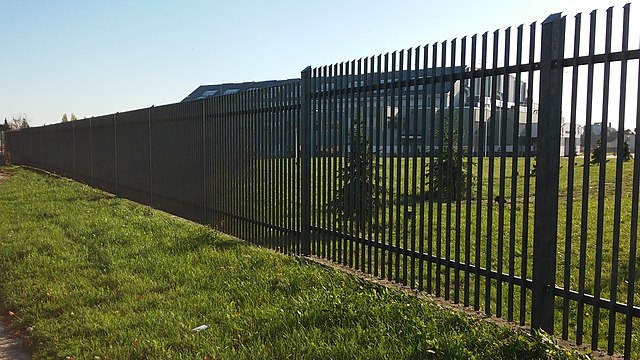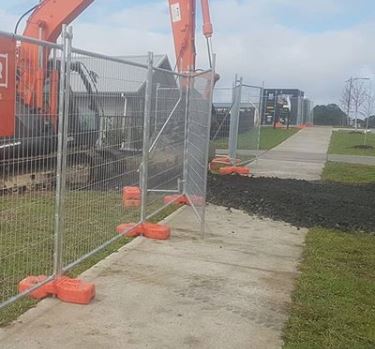Get Retention Pond Maintenance in New Jersey
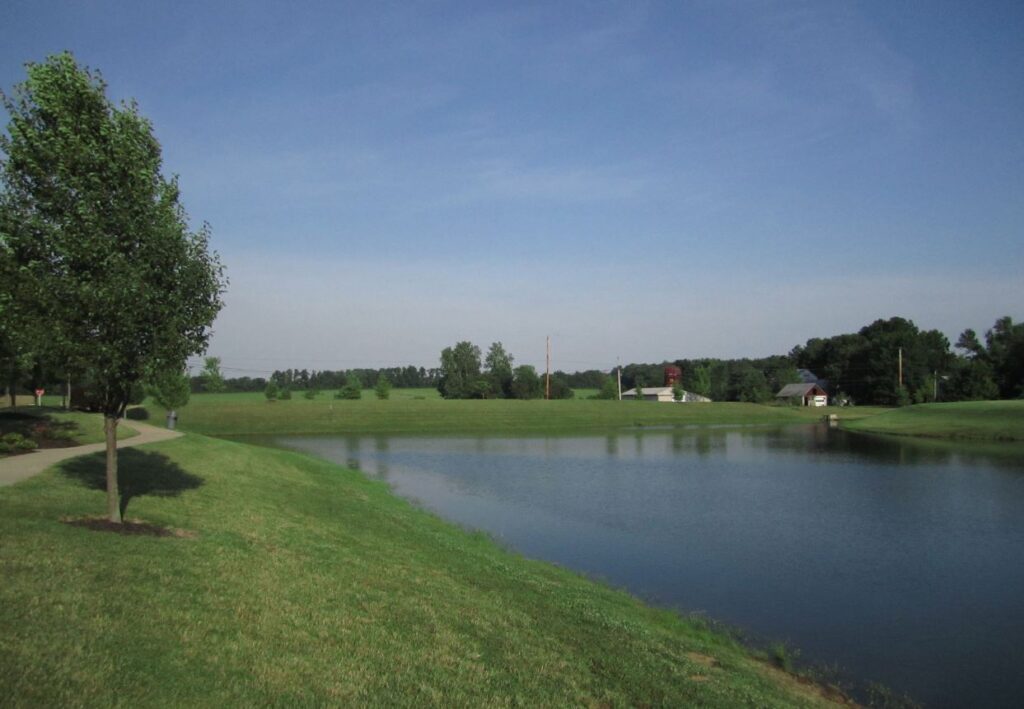
A retention pond, while it may appear to be just another water feature, serves a much more important role. Excess stormwater runoff puts growing towns at greater danger of flooding and erosion. Retention ponds, like dams, are permanent constructions meant to hold water flow for a limited duration. The pond’s water level changes in reaction to a storm, lowering risk and protecting the town from flood damage and costly repairs.
Retention ponds are largely used to improve the quality of urban runoff from residential neighborhoods, roads, parking lots, industrial sites, and commercial sectors, as well as to lower peak stormwater runoff rates by storing water temporarily during heavy storms. They must be kept in good working order and retention pond maintenance is the key to making sure they function properly.
Stormwater runoff, particularly in metropolitan areas, is a substantial source of water contamination. Retention ponds will act as a pollutant treatment basin as well as a collection location for heavier flows, reducing peak runoff rates downstream.
Retention ponds, if not properly maintained, can increase pollutant discharge downstream, increase the instability of downstream channels, raise the risk of downstream flooding, and cause additional aesthetic and other nuisance issues.
What Is the Difference Between Retention and Detention?
Building a pond, or basin, is a common way to manage stormwater. Retention and detention are the two types of ponds or basins.
Retention ponds are water-filled pools that change in reaction to rainfall and runoff. They gather water and release it slowly and steadily, preventing flooding and erosion.
Unless there is a lot of rain, detention ponds are normally dry. They’re made to temporarily store water before slowly draining it to another site.
One of the most prevalent ways for managing stormwater management requirements is detention and retention pond maintenance repair. They not only meet standard criteria, but they also aid in the slowing of runoff, the containment of silt, the collection of rubbish, and the removal of contaminants. Furthermore, as a piece of property gets developed out, they provide an opportunity to add and/or keep a small bit of natural environment present, useful and enjoyable.
Ponds are extremely successful at transferring stormwater runoff at the speed and direction that the property owner and the surrounding neighbors wish. These ponds are designed to give the property a more natural feel.
Call 732-370-0291 or Contact Us For A Retention Pond Quote
How To Build A Retention Pond
A retention pond is a man-made lake or reservoir used to store water for future use. Retention ponds are also used to prevent flooding and to improve water quality in areas with a large amount of runoff.
The best way to build a retention pond is by using a dam and spillway. The dam will hold the water in the pond while the spillway allows excess water to escape during times of heavy rain or flooding. You will also need to build a levee around the perimeter of the pond to keep the water from overflowing.
If you are not able to build a dam and spillway, you can create a detention basin instead.
How To Build A Detention Pond
A detention pond is a man-made basin used to store water for a short period of time. Detention ponds are used to prevent flooding and to improve water quality in areas with a large amount of runoff.
Detention ponds are usually smaller than retention ponds and do not have a dam or spillway. Instead, they rely on gravity to drain the water out of the basin. You will need to build a levee around the perimeter of the pond to keep the water from overflowing.
You can also create a detention basin by excavating a lower area in your yard and lining it with plastic. This will create a space for the water to collect during times of heavy rain or flooding. The water will then drain out of the basin slowly over time.
Retention Pond Maintenance
A poorly maintained retention pond is doomed to fail. If the pond is not owned by the local government, it is the obligation of the association to keep it in functioning order, as well as any costs incurred.
This includes regular inspections to identify and repair areas of erosion, gullies, and other damage, especially after severe storms or heavy rain; removing sediment and debris from the pond before it reaches the outlets; and beautifying the surrounding banks with grass, shrubs, and other vegetation.
When the pond is out of sight and/or there is no plan in place to consistently maintain it, simple maintenance such as mowing, garbage and litter cleanup, modest landscaping, sediment removal, and slope stability are typically overlooked. Bringing a neglected pond up to code can be a significant, unexpected cost as well as a disaster for the environment.
Failures within the pond and property damage downstream might cost hundreds of thousands of dollars. Don’t forget about the attention from local government agencies, as well as the possible fines that come with a failed pond.
Retention Pond Before Maintenance
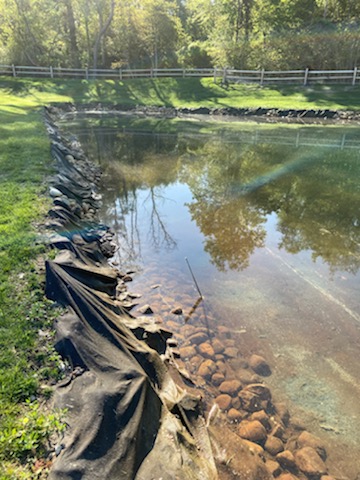

Retention Pond After Maintenance

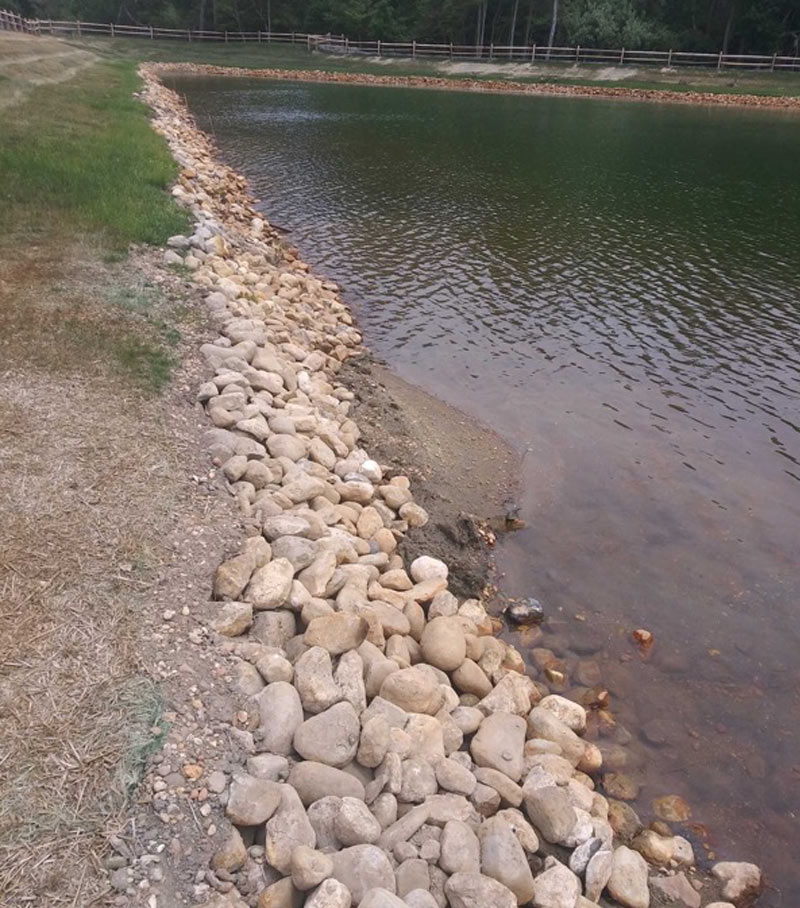
Erosion Prevention
Because of how these systems work, the embankments of retention and detention ponds will gradually erode. They’re made to catch water that flows into the basin from the surface.
Over time, water movement takes its toll on the land. Mowing in the same pattern also helps, which is important because we always make horizontal passes with mowers on slopes for safety.
When erosion happens, soil and debris can flow into the basin, jeopardizing the embankment’s structure and affecting water quality.
Reseeding balding embankments, which is best done in the spring or fall, may be necessary. You may need to add rock to locations where erosion is a serious issue. The goal is to retain soil in place, whether by vegetation or the installation of rock beds that restrict surface water movement.
Blocked Inlets & Outlets must be unblocked
Invasive vegetation thrives in the damp environment surrounding retention and detention ponds. Invasive grasses and weeds grow quicker than many native plants, and they can clog inlets and outlets that must be kept clear to enable proper water flow into basins. Plants have the ability to trap debris, which naturally collects around inflow/outflow locations.
It not only looks bad, but it also hinders your pond from functioning correctly. If it becomes clogged, water will not drain properly, backing up and causing a mess.
Regular maintenance, such as removing weeds and tall grasses that clog pipes, will ensure inlets and outlets function properly. Debris should be cleared away. Rather than allowing the inspector to find a justification to mark the “yes” box for requiring corrective action, keep an eye out for it on a regular basis.
Regular Mowing
The grass and plants that surround a retention or detention pond assist to filter pollutants from storm water, but they should not be allowed to become overgrown.
When it comes to mowing, if you mow your pond’s banks in the same pattern every time, water will flow in the same location, which might lead to erosion. Soil and debris wash into the pond as a result of erosion, lowering the water quality.
As part of routine retention and detention pond maintenance, our mowing workers mow in a different direction each time.
Control the Weeds
Phragmite is an invasive water-loving weed that can grow quickly, and it’s crucial to keep in mind when maintaining retention and detention ponds. The difficulty is that these invasive species can push out other vegetation, particularly erosion-controlling grass. Excess vegetation encroaching on pond embankments is also unattractive.
On a commercial premise, these basins are frequently placed in plain sight. (The inspection report does not include aesthetic appeal; it concentrates on structural soundness.)
When it comes to cattails and phragmites, timing is important. They’ll grow back quickly and aggressively if you trim them down during their growing season, which is spring through summer. This vegetation control should ideally be done in the winter.
Invasive plants such as weeds, cattails, and other invasive species can obstruct water movement and crowd out good vegetation. Weeding is an important aspect of maintaining retention and detention ponds. Keep them at bay.
Keep Ponds and Basins Clean
On the retention pond stone, mucky pond sediment can accumulate. Then, in this muck, grass and plants take root, and the growth can frequently totally hide the stone.
What do expert inspectors check for?
- Trash, dirt, or excessive sediment clogging or obstructing outlets.
- Erosion on the slopes or at the top of the head wall.
- Excessive vegetation around and surrounding the pond.
- Pilot channels should be clear and open.
- Mechanical device functionality (pumps, flood gates, etc.).
- Pipes in the inlet and outlet are in good shape.
- Identify anything that is interfering with the pond’s intended functioning.
What kind of maintenance is required to keep a detention pond in good working order?
- Grass mowing, pruning, and vegetation control
- Keeping trash and garbage out of the pond.
- Keeping mechanical elements in and around the pond in good working order.
- Slopes that have been stabilized.
- Outflow and inflow pipelines are used to remove excess sediment from the basin.
It is not difficult to maintain a detention pond; all that is required is that it be done on a regular basis and correctly. The advantage of maintenance is that it is a low-cost, often attractive stormwater management component that will serve you and the local community for many years.
Maintaining and being accountable
Proper pond care is essential for preventing a variety of issues that can develop from a badly kept stormwater pond. Due to a lack of care, wildlife habitat loss, flooding, and erosion may occur. In many situations, damage is irreversible, especially if nearby bodies of water are damaged.
Some maintenance tasks, such as silt removal or evaluating the soundness of the outlet pipe, stress the importance of pond maintenance on a regular basis. Sediment accumulates in a pond over time and must be removed. This allows for the pond to have enough storage capacity for rainwater and to reduce the quantity of sediment resuspension. A sediment retention pond design is typically to suit specific discharge requirements. To allow the pond to release water at the required pace, erosion around the exit or a collapse of the pipe construction must be addressed immediately.
Stormwater ponds, whether on a commercial or residential property, may fall under the jurisdiction of a business, an individual homeowner, or a homeowner association. The obligation for pond ownership and upkeep is usually defined in the Deed Restrictions for developments, or in a Declaration of Restrictive Covenants if the property is not part of a subdivision. The owners, how it will be paid, and who will ultimately execute inspections and maintenance should all be listed in either document. If you’re not sure who’s responsible, contact your local soil conservation district. They might be able to assist you in determining who is accountable for the stormwater pond’s upkeep.
How Deep Is A Retention Pond
Retention pond basins are man-made water retention basins used to detain or store stormwater runoff. The depths of retention ponds vary, but they can be as deep as 30 feet (9 meters). In order to ensure that a retention pond is effective in trapping sediment and pollutants, the sides of the basin should be steep and sloped at a rate of 3:1. This means that for every 3 feet (1 meter) the water level rises, the height of the side should increase by 1 foot (0.3 meters). This will help keep debris from entering the pond and minimize erosion around its banks. Based on this equation it should be understood that the steeper the slope leading to retaining ponds indicates the depth of the pond.
Maintain the retention and detention basins on a regular basis.
At Eastcoast Sitework, we understand the importance of consistent monitoring and maintenance for retention and detention pond vegetation, debris, and obstructions. By doing so, you can avoid corrective actions on inspection reports and maintain a cost-effective commercial landscape.
Our team of professional commercial landscaping contractors works diligently throughout the year to identify any potential inspection issues. This way, we can address erosion, backup, vegetation, or general upkeep concerns before they escalate into significant problems.
Our services include:
- Retention pond design examples
- Farm pond spillway construction
- Innovative farm pond spillway ideas
- Industrial pond inspection service in South Carolina
- Industrial pond maintenance in South Carolina
- Guidance on retention ponds on your property
- Adherence to retention pond regulations
- Runoff pond management
- Understanding shallow pond meanings
- Pond dam construction and maintenance
- Farm pond creation and upkeep
- Overflow pipe installation and maintenance
- Comprehensive pond construction services
- Plastic pipe utilization for optimal water flow
- Assistance for pond owners seeking professional guidance
- Natural spillway development and maintenance
You can trust Eastcoast Sitework to provide expert erosion control and landscaping solutions to keep your commercial property looking its best.
Adding a retention pond to your new jersey property?
Call 732-370-0291 or Contact Us For A Quote
Frequently Asked Questions
Q: What is industrial shallow pond cleaning?
A: Industrial shallow retention pond cleaning is the process of removing debris, sediment, and other contaminants from ponds. This can be done for both aesthetic and functionality purposes. Common methods of industrial pond cleaning include mechanical removal, chemical treatment, and biological filtration.
Q: What is the difference between retention vs detention?
A: The two terms detention and retention are often confused because they both describe the process of holding water in a reservoir. While they both serve the same purpose, the key difference between the two is that detention ponds are designed to allow water to slowly seep back into the ground, while retention ponds are designed to hold water indefinitely. Some common detention pond problems are erosion, sedimentation, and algae growth.
Q: What is a pond drainage system?
A: A pond drainage system is a system that helps to drain water from a pond. It can be used to remove excess water during periods of heavy rain, or to keep the water level low enough to allow for plants and animals to thrive. There are many different types of pond drainage systems, but they all have one common goal: to promote a healthy pond ecosystem.
Q: Is pond bank stabilization important?
A: Pond bank stabilization is important because if the banks are not stabilized, erosion will occur and the pond will eventually fill with sediment.
Erosion can be caused by a number of factors, such as wind, rain, and runoff from nearby land. If left unchecked, erosion can cause a lot of damage to the pond and its ecosystem. Banks that are stabilized with plants and soil will be much less likely to erode, which will help keep the pond healthy and free of sediment.
Q: What is recommended for algae control in a small pond?
A: There are a few different things you can do to control algae in a small pond. One is to install an ultraviolet light sterilizer, which will kill the algae. You can also add barley straw extract or liquid copper sulfate to the water to inhibit algae growth. Another option is to install an aerator, which will help keep the water circulated and oxygenated and discourage the growth of algae.
Q: What Is Solitude Lake Management?
A: solitude lake management is the process of managing a lake to achieve and maintain the desired state while preserving its natural features. This often includes activities such as fisheries management, water quality improvement, aquatic vegetation control, and erosion control.
Q: What is attenuation pond maintenance?
A: Attenuation pond maintenance is the process of keeping attenuation ponds clean and functioning properly. This can include removing debris, cleaning the pond surface, and fixing any leaks or cracks in the pond liner. It’s important to keep an attenuation pond in good condition to prevent it from becoming clogged and causing flooding or water overflow.
Additional Resources
- Why choose hydroseeding to establish a lawn instead of sod or dry grass seeding?
- Types of Soil Erosion and Mitigation Strategies
- Here is a great post to read more about Wetlands Landscaping Ideas for Commercial Properties in New Jersey.
- Common Sitework Terms and Construction Industry Jargon
- Where Does Stormwater Runoff Go?

